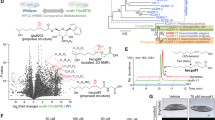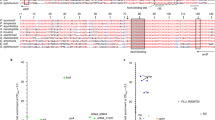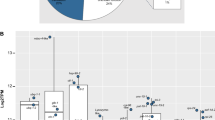Abstract
Microorganisms and their hosts share the same environment, and microbial metabolic molecules (metabolites) exert crucial effects on host physiology1. Environmental factors not only shape the composition of the host’s resident microorganisms, but also modulate their metabolism2. However, the exact molecular relationship among the environment, microbial metabolites and host metabolism remains largely unknown. Here, we discovered that environmental methionine tunes bacterial methyl metabolism to regulate host mitochondrial dynamics and lipid metabolism in Caenorhabditis elegans through an endocrine crosstalk involving NR5A nuclear receptor and Hedgehog signalling. We discovered that methionine deficiency in bacterial medium decreases the production of bacterial metabolites that are essential for phosphatidylcholine synthesis in C. elegans. Reductions of diundecanoyl and dilauroyl phosphatidylcholines attenuate NHR-25, a NR5A nuclear receptor, and release its transcriptional suppression of GRL-21, a Hedgehog-like protein. The induction of GRL-21 consequently inhibits the PTR-24 Patched receptor cell non-autonomously, resulting in mitochondrial fragmentation and lipid accumulation. Together, our work reveals an environment–microorganism–host metabolic axis regulating host mitochondrial dynamics and lipid metabolism, and discovers NR5A–Hedgehog intercellular signalling that controls these metabolic responses with critical consequences for host health and survival.
This is a preview of subscription content, access via your institution
Access options
Access Nature and 54 other Nature Portfolio journals
Get Nature+, our best-value online-access subscription
$29.99 / 30 days
cancel any time
Subscribe to this journal
Receive 12 print issues and online access
$209.00 per year
only $17.42 per issue
Buy this article
- Purchase on Springer Link
- Instant access to full article PDF
Prices may be subject to local taxes which are calculated during checkout





Similar content being viewed by others
References
Lee, W.-J. & Hase, K. Gut microbiota-generated metabolites in animal health and disease. Nat. Chem. Biol. 10, 416–424 (2014).
Muegge, B. D. et al. Diet drives convergence in gut microbiome functions across mammalian phylogeny and within humans. Science 332, 970–974 (2011).
Hacquard, S. et al. Microbiota and host nutrition across plant and animal kingdoms. Cell Host Microbe 17, 603–616 (2015).
Cases, I., De Lorenzo, V. & Ouzounis, C. A. Transcription regulation and environmental adaptation in bacteria. Trends Microbiol. 11, 248–253 (2003).
Guo, M. S. & Gross, C. A. Stress-induced remodeling of the bacterial proteome. Curr. Biol. 24, R424–R434 (2014).
David, L. A. et al. Diet rapidly and reproducibly alters the human gut microbiome. Nature 505, 559–563 (2014).
Krishnan, S., Alden, N. & Lee, K. Pathways and functions of gut microbiota metabolism impacting host physiology. Curr. Opin. Biotechnol. 36, 137–145 (2015).
Brown, J. M. & Hazen, S. L. The gut microbial endocrine organ: bacterially derived signals driving cardiometabolic diseases. Annu. Rev. Med. 66, 343–359 (2015).
Cabreiro, F. & Gems, D. Worms need microbes too: microbiota, health and aging in Caenorhabditis elegans. EMBO Mol. Med. 5, 1300–1310 (2013).
Heintz, C. & Mair, W. You are what you host: microbiome modulation of the aging process. Cell 156, 408–411 (2014).
Dirksen, P. et al. The native microbiome of the nematode Caenorhabditis elegans: gateway to a new host-microbiome model. BMC Biol. 14, 1–16 (2016).
Wang, M. C., Min, W., Freudiger, C. W., Ruvkun, G. & Xie, X. S. RNAi screening for fat regulatory genes with SRS microscopy. Nat. Methods 8, 135–138 (2011).
Chiang, P. K. et al. S-Adenosylmethionine and methylation. FASEB J. 10, 471–480 (1996).
Bobenchik, A. M., Augagneur, Y., Hao, B., Hoch, J. C. & Ben Mamoun, C. Phosphoethanolamine methyltransferases in phosphocholine biosynthesis: functions and potential for antiparasite therapy. FEMS Microbiol. Rev. 35, 609–619 (2011).
Pessi, G., Kociubinski, G. & Mamoun, C. B. A pathway for phosphatidylcholine biosynthesis in Plasmodium falciparum involving phosphoethanolamine methylation. Proc. Natl Acad. Sci. USA 101, 6206–6211 (2004).
Li, Y., Na, K., Lee, H. J., Lee, E. Y. & Paik, Y. K. Contribution of sams-1 and pmt-1 to lipid homoeostasis in adult Caenorhabditis elegans. J. Biochem. 149, 529–538 (2011).
Gissendanner, C. R. & Sluder, A. E. nhr-25, the Caenorhabditis elegans ortholog of ftz-f1, is required for epidermal and somatic gonad development. Dev. Biol. 221, 259–272 (2000).
Chen, Z., Eastburn, D. J. & Han, M. The Caenorhabditis elegans nuclear receptor gene nhr-25 regulates epidermal cell development. Mol. Cell. Biol. 24, 7345–7358 (2004).
Ward, J. D. et al. Sumoylated NHR-25/NR5A regulates cell fate during C. elegans vulval development. PLoS Genet. 9, e1003992 (2013).
Fu, D. et al. In vivo metabolic fingerprinting of neutral lipids with hyperspectral stimulated Raman scattering microscopy. J. Am. Chem. Soc. 136, 8820–8828 (2014).
Breckenridge, D. G. et al. Caenorhabditis elegans drp-1 and fis-2 regulate distinct cell-death execution pathways downstream of ced-3 and independent of ced-9. Mol. Cell 31, 586–597 (2008).
Rolland, S. G., Lu, Y., David, C. N. & Conradt, B. The BCL-2-like protein CED-9 of C. elegans promotes FZO-1/Mfn1,2- and EAT-3/Opa1-dependent mitochondrial fusion. J. Cell Biol. 186, 525–540 (2009).
Walker, A. K. et al. A conserved SREBP-1/phosphatidylcholine feedback circuit regulates lipogenesis in metazoans. Cell 147, 840–852 (2011).
Rudel, T., Kepp, O. & Kozjak-Pavlovic, V. Interactions between bacterial pathogens and mitochondrial cell death pathways. Nat. Rev. Microbiol. 8, 693–705 (2010).
Govindan, J. A., Jayamani, E., Zhang, X., Mylonakis, E. & Ruvkun, G. Dialogue between E. coli free radical pathways and the mitochondria of C. elegans. Proc. Natl Acad. Sci. USA 112, 12456–12461 (2015).
Neve, I., Sowa, J. & Wang, M. C. Modified E. coli B strain OP50 facilitates RNA interference induction in C. elegans. Worm Breeder’s Gazette 20, 3 (2015).
Ramachandran, P. V., Mutlu, A. S. & Wang, M. C. Label-free biomedical imaging of lipids by stimulated Raman scattering microscopy. Curr. Protoc. Mol. Biol. 109, 30.3.1–30.3.17 (2015).
Edwards, C. R., Dang, W. & Berger, S. L. Histone H4 lysine 20 of Saccharomyces cerevisiae is monomethylated and functions in subtelomeric silencing. Biochemistry 50, 10473–10483 (2011).
Brooks, J. R., Griffin, V. K. & Kattan, M. W. A modified method for total carbohydrate analysis of glucose syrups, maltodextrins, and other starch hydrolysis products. Cereal Chem. 63, 465–467 (1986).
Evans, A. M., DeHaven, C. D., Barrett, T., Mitchell, M. & Milgram, E. Integrated, nontargeted ultrahigh performance liquid chromatography/electrospray ionization tandem mass spectrometry platform for the identification and relative quantification of the small-molecule complement of biological systems. Anal. Chem. 81, 6656–6667 (2009).
Bratic, I. et al. Mitochondrial DNA level, but not active replicase, is essential for Caenorhabditis elegans development. Nucleic Acids Res. 37, 1817–1828 (2009).
Lemos, M. L., Toranzo, A. E. & Barja, J. L. Modified medium for the oxidation-fermentation test in the identification of marine bacteria. Appl. Environ. Microbiol. 49, 1541–1543 (1985).
Acknowledgements
We thank J. Mello (Harvard Medical School, USA) for providing strains JM45 and JM43, J. Mamrosh (Caltech, USA) for providing MH1955 strain, HeLa cells and discussion, G. Ruvkun (Harvard Medical School, USA) for providing daf-16(mgDf47), J. J. Wang (University of Wisconsin-Madison, USA) for providing MG1655 bacteria and discussion, J. Sowa and I. Neve for providing OP50 RNAi bacteria, K. H. L. Mak for providing strain raxIs49, W. Dang and H. Liu for biochemical support, Y. Yu and A. S. Mutlu for the SRS support, A. Dervisefendic, H. D. Oakley and P. Svay for maintenance support, H. Liang and L. Han for RNA-seq bioinformatic support, C. Herman, D. Moore, A. Yu, A. Folick and S. Choi for discussions, and H. Dierick, C. Herman and C.-L. F. Li for critical reading of the manuscript. We appreciate the NBRP (Japan) and the CGC (USA) for providing mutant strains. The CGC is funded by NIH Office of Research Infrastructure Programs (P40 OD010440). This work was supported by grants from HHMI (M.C.W.) and National Institute of Health (R01AG045183, R01AT009050, DP1DK113644, M.C.W.), and in part by a training fellowship from the Burroughs Wellcome Fund—The Houston Laboratory and Population Science Training Program in Gene-Environment Interaction of the University of Texas Health Science Center at Houston (BWF Grant 1008200, C.-C.J.L.).
Author information
Authors and Affiliations
Contributions
C.-C.J.L. and M.C.W. wrote the manuscript. C.-C.J.L. and M.C.W. conceived and designed the study. C.-C.J.L. conducted the experiments.
Corresponding author
Ethics declarations
Competing interests
The authors declare no competing financial interests.
Integrated supplementary information
Supplementary Figure 1 Physiological measurements in C. elegans living on MG1655LB and MG1655M9.
(a) Adult C. elegans significantly increase or decrease fat content levels within 24 hours of switching to MG1655M9 or MG1655LB, respectively. ∗p < 0.05, ∗∗p < 0.01, Student’s t-test; n = 3 biologically independent experiments. (b,c) C. elegans raised on MG1655LB and on MG1655M9 show similar rates of pharyngeal pumping (b) and defecation (c), indicating comparable food intake rate and food retention time. Error bars represent standard deviation (SD). p > 0.05, Student’s t-test; n = 3 biologically independent experiments. (d) C. elegans raised on MG1655LB and MG1655M9 show indistinguishable rates of lipid absorption, assayed by a lipophilic BODIPY fluorescence dye. p > 0.05, Student’s t-test; n = 10 biologically independent animals. The box plots were generated to indicate ranges of min to max values, with 25th, 50th and 75th percentiles. (e–g) C. elegans raised on MG1655LB and MG1655M9 show similar levels of mobility (e, p > 0.05, Student’s t-test; n = 11 biologically independent animals), lifespan (f, p > 0.05, Log-rank test; n = 100 biologically independent animals), and brood size (g, p > 0.05, Student’s t-test; n = 18 biologically independent animals). The experiments were independently replicated in laboratory 3 times with similar results. (h) C. elegans raised on E. coli cultured in M9 medium supplemented with either peptone or casamino acids (CAA) show reduced lipid accumulation, compared with those on MG1655M9. ∗∗p < 0.01, ∗∗∗p < 0.001, Student’s t-test; n = 5 biologically independent experiments. (i) With bacteria killed by carbenicillin (60 μg/ml), MG1655M9-conferred lipid accumulation in C. elegans can still be significantly suppressed by supplementation of methionine but not betaine or homocysteine. ∗∗∗p < 0.001, ∗∗p < 0.01, n.s. p > 0.05, Student’s t-test. ##p < 0.01, n.s. p > 0.05, two-way ANOVA; n = 3 biologically independent experiments. (j) Mitochondrial DNA copy numbers are not significantly different among C. elegans raised on MG1655LB, MG1655LB+Methionine, MG1655M9, and MG1655M9+Methionine, n.s. p > 0.05, one-way ANOVA; n = 3 biologically independent experiments. (k) The fzo-1(tm1333) mutant exhibits completely fragmented mitochondrial morphology. p < 0.001, Chi-squared test; n = 50 biologically independent cells. The experiments were independently replicated in laboratory 3 times with similar results. Error bars represent mean ± standard error of the mean (SEM).
Supplementary Figure 2 Nutritional characterizations in E. coli MG1655LB and E. coli MG1655M9.
(a) Oxygen bomb calorimetry revealed similar caloric values in MG1655LB and MG1655M9. (b,c) The levels of triacylglycerides (b) and proteins (c) were measured biochemically and found no significant differences between MG1655LB and MG1655M9. n.s. p > 0.05, Student’s t-test; n = 7 biologically independent experiments (b), n = 5 biologically independent experiments (c). (d) MG1655M9 has a higher level of carbohydrates than MG1655LB. ∗p < 0.05, Student’s t test; n = 6 biologically independent experiments. (e) Fermenting MG1655LB+glucose (with 0.2% glucose), as verified in (f), is not sufficient to recapitulate MG1655M9-conferred lipid accumulation in C. elegans. C. elegans on MG1655LB (without glucose) served as negative controls. n.s. p > 0.05, Student’s t-test; n = 3 biologically independent experiments. (f) In phenol red fermentation tests, MG1655M9 shows positive fermentation (yellow), but MG1655LB shows negative fermentation (red). Addition of glucose (0.2%) to LB is sufficient to drive MG1655LB+glucose to undergo fermentation. The experiments were independently replicated in laboratory 3 times with similar results. Error bars represent mean ± SEM.
Supplementary Figure 3 Search of endocrine signaling candidates by bioinformatics.
The Venn diagram showing 188 overlapped genes that are differentially regulated between C. elegans grown on MG1655LB and MG1655M9 (NCBI BioProject ID PRJNA378539) and are found in NHR-25 ChIP-seq (modENCODE project, NCBI BioProject ID PRJNA13758). The identities of these 188 genes are listed in Supplementary Table 3a.
Supplementary information
Supplementary Information
Supplementary Information (PDF 270 kb)
Supplementary Table 1
Supplementary Information (XLSX 22 kb)
Supplementary Table 2
Supplementary Information (XLSX 51 kb)
Supplementary Table 3
Supplementary Information (XLSX 15 kb)
Rights and permissions
About this article
Cite this article
Lin, CC., Wang, M. Microbial metabolites regulate host lipid metabolism through NR5A–Hedgehog signalling. Nat Cell Biol 19, 550–557 (2017). https://doi.org/10.1038/ncb3515
Received:
Accepted:
Published:
Issue Date:
DOI: https://doi.org/10.1038/ncb3515
This article is cited by
-
It is the time for quorum sensing inhibition as alternative strategy of antimicrobial therapy
Cell Communication and Signaling (2023)
-
Environment factors, DNA methylation, and cancer
Environmental Geochemistry and Health (2023)
-
Host and microbiota metabolic signals in aging and longevity
Nature Chemical Biology (2021)
-
C. elegans: A biosensor for host–microbe interactions
Lab Animal (2021)
-
Olfactory specificity regulates lipid metabolism through neuroendocrine signaling in Caenorhabditis elegans
Nature Communications (2020)



